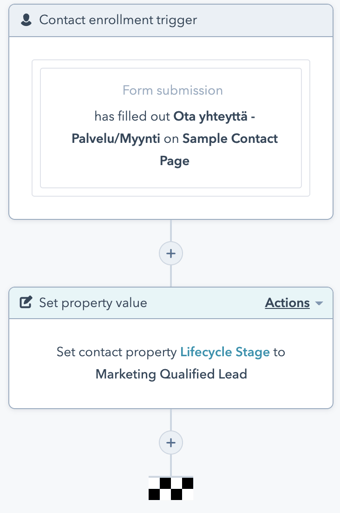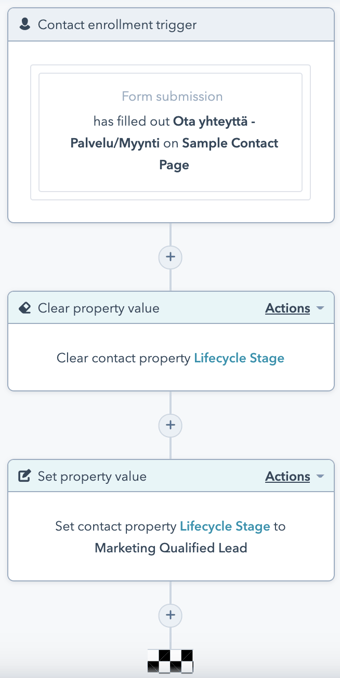This article, in shortLearn why lifecycle stages should be the foundation of your sales and marketing reporting. This article is a must-read for sales and marketing teams trying to understand HubSpot's lifecycle stages and how they work. |
Simply put, the lifecycle stage provides information on the current situation or customer journey of a contact or company.
As the name suggests, it tells whether a given contact or company is, for instance, a current customer or an open sales opportunity.
Why track them?
Tracking the customer journey and using contact lifecycle stages in HubSpot CRM can help companies better understand their funnel and improve their ability to meet the needs of their customers and potential customers.
By analyzing customer interactions and behaviors at different stages of the lifecycle, you can 1. identify bottlenecks affecting your growth and 2. identify opportunities to improve the customer experience.
Let’s take an example:
- A company is using a CRM to track customer interactions from the initial point of contact through the sales process and beyond.
- By analyzing this data, they identify areas where the customer experience can be improved by providing additional resources or support during the onboarding process or by proactively reaching out to customers to address potential issues before they become problems.
What are the default lifecycle stages on HubSpot?

- A Subscriber is a contact who has opted in to receive regular content, such as a blog or newsletter. This stage identifies contacts who are interested in your content but may not yet be ready to engage with your products or services.
- A Lead is a contact who has shown interest beyond just subscribing to your blog or newsletter, typically through engaging with your marketing efforts. This could include filling out a form to download a guide or attending a webinar. This stage captures contacts who are more engaged and potentially closer to becoming customers.
- A Marketing Qualified Lead (MQL) is a contact who has engaged with your marketing content to a degree that indicates they have the potential to become customer (based on specific attributes or attitudes they share with your existing customers). This could include downloading multiple eBooks, attending several webinars, or visiting high-value pages on your website. This stage identifies contacts who are ready to be handed over to the sales team for further qualification.
- A Sales Qualified Lead (SQL) is a contact that the sales team has qualified as a potential customer. This could be someone who has been contacted by the sales team and has shown interest in purchasing your product or service. This stage focuses sales efforts on contacts who are most likely to convert into customers.
- An Opportunity is a contact who is associated with a potential deal or sale. This could be someone who has been identified as a good fit for your product or service and is actively engaged in the sales process. This stage tracks contacts who are in the pipeline for a potential sale.
- A Customer is a contact who has made a purchase and is a current customer. This stage manages and nurtures relationships with existing customers to encourage repeat business and loyalty.
- An Evangelist is a contact who is not only a customer but also an advocate for your brand. This could be someone who leaves positive reviews, refers new customers, or promotes your brand on social media. This stage leverages the influence of satisfied customers to attract new business.
- The Other category is a catch-all for contacts who do not fit into any of the above stages. This could include contacts who have been imported from another system or whose status is unclear. This stage ensures that all contacts are accounted for, even if their lifecycle stage is not immediately clear.
What about custom lifecycle stages?
“The default options offered by HubSpot CRM don't fit our approach. Can I build custom ones?”
Yes!
Simply log into your HubSpot account and go to Settings > Objects > Contacts > Lifecycle Stage.

Note that the lifecycle stage property is simply a drop-down menu among other properties. If needed, you can reorder the default properties or create and customize your own.
I’ll go over the default rules in more detail next.
HubSpot CRM's lifecycle stage default rules
By default, lifecycle stage and lead status properties change in HubSpot in the following cases:
- When creating a new contact
- Throughout the sales process
The default rules mentioned here only apply when using HubSpot's own default lifecycle stage.
Lifecycle stage change when creating a new contact
By default, a new contact becomes a subscriber if they are created in HubSpot in one of the following ways:
- Manually added by a user
- Manually imported from a CSV file
- As a result of a conversation with a contact (e.g. chat or messenger).
- When the contact joins the newsletter list or subscribes to the blog feed
By default, a new contact becomes a lead if they are created in HubSpot in one of the following ways:
- When they fill out a form
- When a HubSpot user selects "create a new contact" when sending an email to a contact from their own Gmail or Outlook connected to HubSpot
- Through your Salesforce integration
Lifecycle stage change during the sales process
When a contact or company moves to the sales process in HubSpot, (i.e. we go to the pipeline and create a deal), the lifecycle stage for both the company and the contact becomes Opportunity by default.
From there on, the default value will remain as “Opportunity” until the deal is closed and won. After which the lifecycle stage automatically changes to Customer.
Note that, by default, the lifecycle stage will remain as an opportunity if your sales team closes a deal as lost.
Exceptions to HubSpot CRM's lifecycle stage default rules
There are a few exceptions to the default rules that sometimes make it difficult to understand the lifecycle property logic.
The lifecycle stage is automatically updated only forward
HubSpot will never update the lifecycle stage backward (unless you set it to do so using a workflow, for instance).
Example: If an MQL, Opportunity or Customer subscribes to your blog, they won’t become a subscriber. They will remain either an MQL, Opportunity or Customer.
The Customer value does not change
Example: If a contact or company is labeled as Customer, the stage property will not change to Opportunity if a new deal is opened for the same customer.
You will also need to edit the stage manually when a customer churns.
Let’s now see how it works with a couple of examples.
How to update the lifecycle stage in HubSpot CRM?
Updating the lifecycle stage can either be done manually, or with a little help from workflows.
When updating manually, you can give the desired value either to a single contact or to several contacts at the same time.
Note that when updating the lifecycle stage backward using a workflow, one extra step has to be done: the current value must first be deleted before a new value can be entered.
Example 1: Assigning a specific stage value via a workflow
In the example below, the a contact became a marketing qualified lead after filling out a form.
- If a contact whose current value is subscriber or lead enters the workflow, the new value for them will be marketing qualified lead.
- If a contact whose current lifecycle stage value is sales qualified lead, opportunity, customer, evangelist, or other enters the workflow, the current value will not change.

Example 2: Clearing the lifecycle stage and updating it to a certain value with a workflow
This example is similar to Example 1, except for one extra step: clear property value.
- Regardless of the contact's stage value when enterring into the workflow, they will become an MQL in this case.

Do the lifecycle stage of the contact and the company have to be the same?
Not necessarily.
Now, apart from specific exceptions, it usually makes sense to align those.
Having said that, with the default settings, a contact's lifecycle value is will always reflect the attached company stage. If you want to follow a different method, you have to manually turn off the setting shown below (Company settings > Lifecycle stage sync).
If you tick the stage sync, the company associated to a won deal will automatically become a customer. And all contacts associated with the company will too.
Now, it can be interesting to not sync lifecycle stage value between a company and the associated contacts.
For example, in some cases, it could be relevant to keep contacts marked as Evangelist or Other if you need to segment them in a specific way to create more relevant experiences.
What are the different use cases for lifecycle stage in HubSpot CRM?
The lifecycle stage is an excellent tool for connecting marketing and sales processes and set clear responsibilities.
For instance, you could use it to define that contacts from the Subscriber to the MQL stage are the responsibility of marketing (a pretty common way to do it) and leave SQLs and Opportunities to sales.
Of course, following this approach requires a strong sales and marketing alignment so that there’s no abyssal gap between leads marketing say are qualified (MQLs) and leads sales believe are mature enough (SQLs).
Here are a couple more use cases for it.
In automations
As a hidden field in forms
Where you can directly define a specific value for the lifecycle stage.
In reporting
To give an overall picture of the distribution of contacts according to the lifecycle stage, or as a funnel to show the transition of contacts from one stage to another.
Tracking the customer journey can help a company identify trends and patterns in customer behavior, which can inform marketing and sales strategies.
For example, a company might use data from its CRM to identify common pain points or challenges that customers face at different stages of the lifecycle and then develop targeted marketing campaigns or sales strategies to address those issues.
Map your funnel and optimize it
To make a long story short, using contact lifecycle stages and monitoring how your contacts move down your funnel should be the foundation of sales and marketing reporting. If your HubSpot properties match your real-life situation, this simple feature will help segment your actions and comms to build stronger relationships with your customers and drive business growth.
—
Don’t know where to start? Or maybe you’d like someone to look at your martech stack? Reach out, and we’ll send our tech wizards your way!



